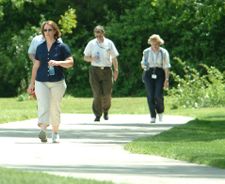Difference between revisions of "Category:642 Pedestrian Facilities"
Jump to navigation
Jump to search
(→Agreements: minor clarification) |
(Per DE, please closely read the article since most of the article has been re-written.) Tag: Replaced |
||
| (9 intermediate revisions by 2 users not shown) | |||
| Line 1: | Line 1: | ||
| − | [[Image: | + | [[Image:642a.jpg|right|225px]] |
| − | |||
| − | + | MoDOT values the needs of all transportation users, including pedestrians. Safe, convenient and well-designed transit and pedestrian facilities are essential to Missouri communities. Pedestrian safety needs to be considered on every MoDOT project, especially when pedestrians are expected in close proximity to roadway traffic. | |
| − | |||
| − | |||
| − | |||
| − | |||
| − | |||
| − | |||
| − | |||
| − | |||
| − | |||
| − | |||
| − | |||
| − | |||
| − | |||
| − | |||
| − | |||
| − | |||
| − | |||
| − | |||
| − | |||
| − | |||
| − | |||
| − | |||
| − | |||
| − | |||
| − | |||
| − | |||
| − | |||
| − | |||
| − | |||
| − | |||
| − | |||
| − | |||
| − | |||
| − | |||
| − | |||
| − | |||
| − | |||
| − | |||
| − | |||
| − | |||
| − | |||
| − | |||
| − | |||
| − | |||
| − | |||
| − | |||
| − | |||
| − | |||
| − | |||
| − | |||
| − | |||
| − | |||
| − | |||
| − | |||
| − | |||
| − | |||
| − | |||
| − | |||
| − | |||
| − | |||
| − | |||
| − | |||
| − | |||
| − | |||
| − | |||
| − | |||
| − | |||
| − | |||
| − | |||
| − | |||
| − | |||
| − | |||
| − | |||
| − | |||
| − | |||
| − | |||
| − | |||
| − | |||
| − | |||
| − | |||
| − | |||
| − | |||
| − | |||
| − | |||
| − | |||
| − | |||
| − | |||
| − | |||
| − | |||
| − | |||
| − | |||
| − | |||
| − | |||
| − | |||
| − | |||
| − | |||
| − | |||
| − | |||
| − | |||
| − | |||
Latest revision as of 10:20, 20 March 2020
MoDOT values the needs of all transportation users, including pedestrians. Safe, convenient and well-designed transit and pedestrian facilities are essential to Missouri communities. Pedestrian safety needs to be considered on every MoDOT project, especially when pedestrians are expected in close proximity to roadway traffic.
Articles in "642 Pedestrian Facilities"
The following 14 pages are in this category, out of 14 total.
6
- 642.1 Integrating Non-Motorized Facilities
- 642.2 Consideration of Pedestrian Facilites on Projects
- 642.3 Americans with Disabilities Act of 1990
- 642.4 Impact of the Project Category on ADA
- 642.5 Maximum Extent Feasible
- 642.6 Local Projects and ADA Considerations
- 642.7 Maintenance Responsibility
- 642.8 Sidewalk Design Criteria
- 642.9 Sidewalk Ramp and Curb Ramp Design Criteria
- 642.10 Curb Ramp Applications
- 642.11 Pedestrian Grade Separations
- 642.12 Pedestrians and Roundabouts
- 642.13 ADA Self-Evaluation
- 642.14 ADA Transition Plan
